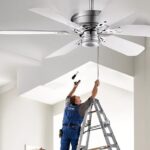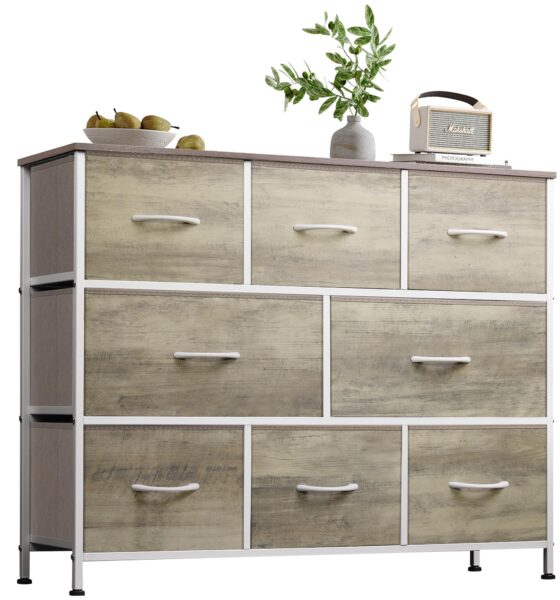Appliances
Expert Advice: Who Should Install Your Ceiling Fan?
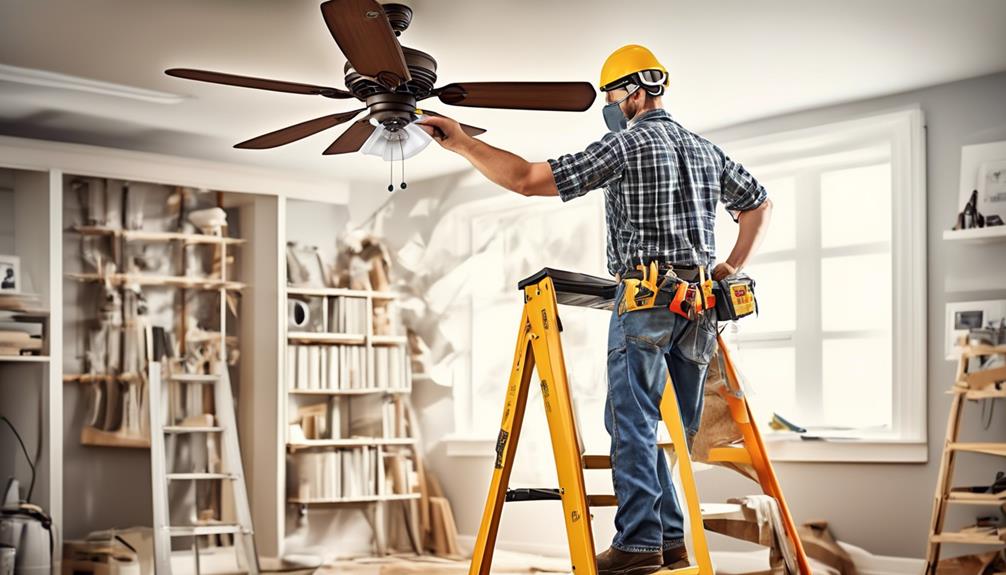
In determining who should install a ceiling fan, it’s important to think about the most qualified individual for the job.
Like birds building their nests, some of us possess the innate ability to tackle home improvement projects with ease. DIY enthusiasts, with their skills and determination, can confidently take on the installation process.
Homeowners with electrical experience have the knowledge and expertise to handle the wiring aspect.
Individuals with handyman skills possess the dexterity and know-how to complete the job efficiently.
Those with limited budgets may opt to install the ceiling fan themselves to save on costs.
Lastly, homeowners with safety concerns may prefer to hire a professional to ensure a secure installation.
Key Takeaways
- DIY enthusiasts, homeowners with electrical experience, and individuals with handyman skills can install a ceiling fan themselves.
- Installing a ceiling fan yourself can be a cost-effective solution for those with limited budgets.
- Homeowners with safety concerns may prefer to hire professionals for secure installation.
- Homeowners with mobility issues should install a ceiling fan with a remote control or a wall-mounted switch for ease of operation.
DIY Enthusiasts
DIY enthusiasts often find great satisfaction in installing their own ceiling fans, taking on the challenge and enjoying the benefits of a cool and refreshing breeze in their homes. For DIY beginners, installing a ceiling fan can be a rewarding project to start with. With the right tools and a step-by-step guide, apartment dwellers can successfully tackle this task.
Before diving into the installation process, it's essential to gather the necessary tools and materials. These include a ladder, screwdriver, wire stripper, pliers, and the ceiling fan kit. It's crucial to read the instruction manual thoroughly to understand the installation steps and safety precautions.
Next, it's important to turn off the power to the room at the circuit breaker to ensure safety during the installation process. Once the power is turned off, the existing light fixture can be removed, exposing the electrical box.
The ceiling fan kit will come with a mounting bracket, which should be securely attached to the electrical box using screws. The fan's wiring should be carefully connected to the corresponding wires in the electrical box, ensuring proper insulation and tight connections.
Once the wiring is complete, the fan blades and the light fixture, if applicable, can be attached. The fan should be tested to ensure it's functioning properly before securing it to the mounting bracket.
Homeowners With Electrical Experience
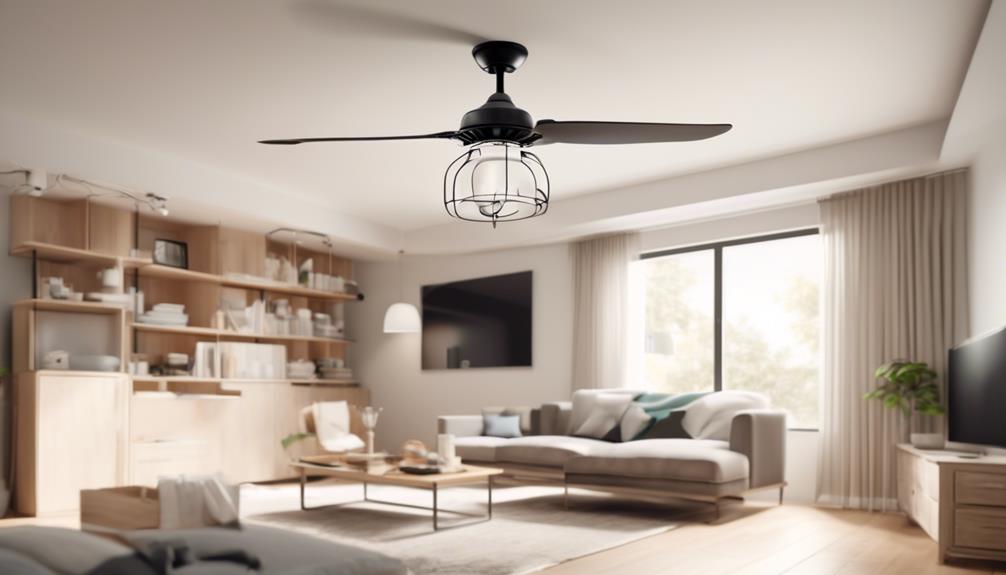
For those of us who've experience working with electrical systems, installing a ceiling fan can be a straightforward task that allows us to enjoy the benefits of improved air circulation in our homes. As homeowners with electrical experience, we possess the necessary knowledge and skills to safely handle the electrical components involved.
However, it's important to note that even though we may have a good grasp of electrical work, we aren't electrical professionals or licensed electricians. This means that there are certain limitations to what we can do when it comes to electrical installations.
While we may feel confident in our abilities to install a ceiling fan, it's crucial to recognize when a task exceeds our expertise. For example, if the installation requires complex wiring or modifications to the existing electrical system, it's best to leave it to the professionals.
Electrical professionals, such as licensed electricians, have undergone extensive training and have the necessary certifications to ensure the job is done safely and up to code.
Individuals With Handyman Skills
Individuals with handyman skills can also tackle the installation of a ceiling fan with the right tools and knowledge. If you have experience working with electrical systems and are comfortable with basic wiring and electrical connections, you can save money by installing a ceiling fan yourself instead of hiring handyman services. However, it's crucial to follow proper installation techniques and safety precautions to ensure a successful and safe installation.
Before starting the installation process, gather the necessary tools such as a ladder, screwdriver, wire stripper, and voltage tester. Additionally, ensure that you have a suitable ceiling fan kit that includes all the required components.
Start by turning off the power to the room and removing the existing light fixture or fan. Follow the manufacturer's instructions carefully to mount the ceiling fan bracket and secure it to the electrical box. Then, connect the wiring, making sure to match the corresponding colors and secure them with wire nuts. Finally, attach the fan blades, light kit, and any additional features according to the provided instructions.
Those With Limited Budgets
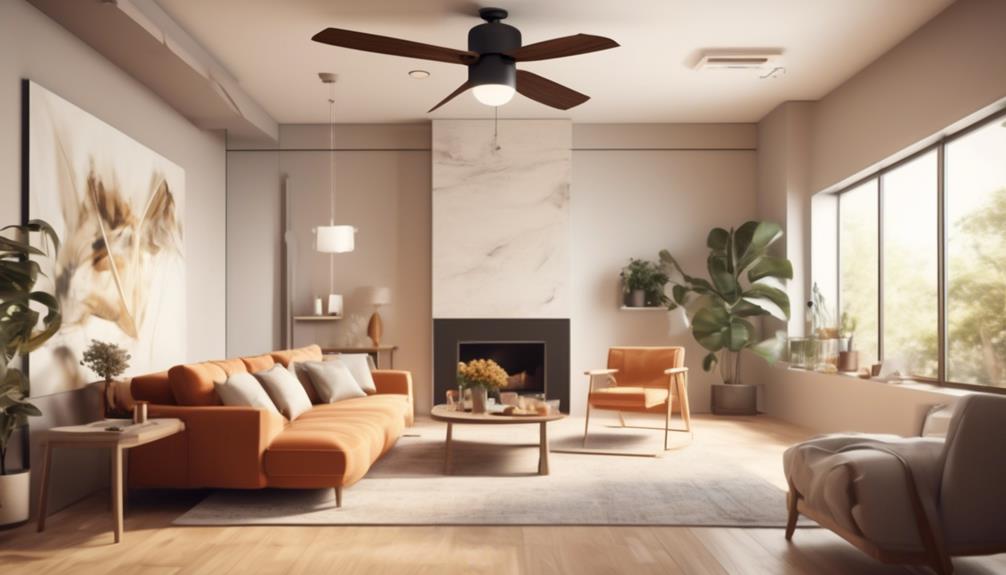
If you have a limited budget, installing a ceiling fan yourself can be a cost-effective solution. Fortunately, there are affordable options available that can suit your financial constraints.
When it comes to installation, there are a few tips to keep in mind.
Firstly, before purchasing a ceiling fan, ensure that it's compatible with your electrical system. Check the voltage and amperage requirements to avoid any issues during installation. Additionally, consider the size of the room where the fan will be installed. A larger room may require a fan with a longer blade span to effectively circulate air.
Next, gather all the necessary tools and materials beforehand. This includes a ladder, screwdriver, wire strippers, electrical tape, and wire nuts. It's important to turn off the power to the room at the circuit breaker before starting any electrical work. Safety should always be a top priority.
Follow the manufacturer's instructions carefully during installation. Begin by mounting the fan bracket to the ceiling, ensuring it's securely fastened. Then, connect the wiring, making sure to match the colors of the wires and using wire nuts to secure the connections. Finally, attach the fan blades and turn on the power to test the fan.
Homeowners With Safety Concerns
Homeowners with safety concerns should prioritize proper installation techniques and follow safety guidelines to ensure the secure and efficient operation of their ceiling fan. It's crucial to consider the specific needs of individuals with high ceilings or homeowners with mobility issues when installing a ceiling fan. For those with high ceilings, it's essential to use an appropriate extension rod to ensure that the fan is installed at an optimal height for air circulation and functionality. Additionally, homeowners with mobility issues should consider installing a ceiling fan with a remote control or wall-mounted switch for ease of operation.
When installing a ceiling fan, it's vital to adhere to safety guidelines to prevent accidents and ensure the longevity of the fan. Before installation, homeowners should turn off the power supply to avoid any electrical mishaps. It's also important to use the correct tools and equipment and to follow the manufacturer's instructions carefully. Regular maintenance is crucial to keep the fan in optimal working condition. Homeowners should regularly clean the fan blades and check for any loose or damaged parts that may affect the fan's performance or safety.
Frequently Asked Questions
Can I Install a Ceiling Fan Myself if I Have No Electrical Experience?
Installing a ceiling fan without professional help can be a risky endeavor, especially if you lack electrical experience. Without the necessary knowledge, you run the risk of electrocution or improperly wiring the fan, which can lead to malfunctions or even fires.
It's crucial to prioritize safety and seek the expertise of a licensed electrician who can ensure a proper installation. Remember, when it comes to electrical work, it's always better to err on the side of caution.
How Much Does It Typically Cost to Hire a Professional to Install a Ceiling Fan?
When considering the ceiling fan installation cost, hiring a professional is a wise choice. They possess the necessary expertise and technical know-how to ensure a precise and efficient installation.
Are There Any Safety Precautions I Should Take When Installing a Ceiling Fan?
When installing a ceiling fan, it's crucial to prioritize electrical safety and proper mounting techniques.
We must take every precaution to ensure that the electrical wiring is done correctly and that all connections are secure.
Additionally, it's essential to follow the manufacturer's instructions for proper mounting to prevent any potential hazards.
What Tools and Equipment Do I Need to Install a Ceiling Fan?
When installing a ceiling fan, there are certain tools and equipment that we need to ensure a successful installation process.
Some of the tools and equipment required include a ladder, screwdriver, pliers, wire stripper, voltage tester, and wire connectors.
Additionally, it's important to have a ceiling fan kit that includes the fan, mounting brackets, screws, and instructions.
A step-by-step guide for installing a ceiling fan is crucial to follow.
Are There Any Specific Building Codes or Regulations I Need to Adhere to When Installing a Ceiling Fan?
When it comes to the building code requirements for ceiling fan installation, we've got you covered. It's essential to adhere to these regulations to ensure a safe and efficient setup.
Common mistakes to avoid include improper wiring and insufficient support. Remember, precision is key when dealing with electrical work. So, if you're not confident in your abilities, it's best to leave it to the professionals.
Ensure a job well done by consulting with a licensed electrician who knows the ins and outs of the building codes.
Conclusion
In conclusion, it's clear that only the most skilled and experienced individuals should attempt to install a ceiling fan. The task requires a deep understanding of electrical work, handyman skills, and a keen eye for safety.
For those lacking in these areas, it's best to seek professional help. Remember, the fan may spin peacefully above your head, but a poorly installed one could come crashing down on your dreams of a cool and comfortable home.
Stay safe and leave it to the experts.
- About the Author
- Latest Posts
Introducing Ron, the home decor aficionado at ByRetreat, whose passion for creating beautiful and inviting spaces is at the heart of his work. With his deep knowledge of home decor and his innate sense of style, Ron brings a wealth of expertise and a keen eye for detail to the ByRetreat team.
Ron’s love for home decor goes beyond aesthetics; he understands that our surroundings play a significant role in our overall well-being and productivity. With this in mind, Ron is dedicated to transforming remote workspaces into havens of comfort, functionality, and beauty.
Appliances
Red Porch Light Meaning

Have you ever seen a red porch light in your area and questioned its significance?
It's a common sight that often goes unnoticed, but the meaning behind it holds significant importance in various contexts.
From honoring veterans to raising awareness for substance abuse and supporting anti-trafficking initiatives, the red porch light holds diverse symbolism.
Understanding the reasons behind this choice of illumination can shed light on important societal issues and initiatives worth exploring.
Key Takeaways
- The red porch light originated as a symbol of hope and support for families of military personnel during World War II.
- The red porch light is a symbol of support and gratitude for veterans, raising awareness about their challenges and fostering community engagement in supporting their well-being.
- Advocating for substance abuse awareness involves shining a light on addiction's impact and creating supportive communities to foster prevention and provide necessary assistance.
- The red porch light raises awareness of mental health issues, supports stigma reduction, and promotes prioritization of mental health, while community-driven initiatives demonstrate the power of collective efforts in advocating for mental health and supporting those in need.
Historical Origins

Have you ever wondered about the historical origins of the red porch light and its significance?
The red porch light has a rich historical background that dates back to the early 20th century. Its cultural significance stems from its association with American tradition during times of war. In the early 1940s, as World War II raged on, families of military personnel would keep a red porch light illuminated as a symbol of hope and a quiet reminder of their loved ones serving overseas. This act of solidarity also served as a beacon for servicemen, signifying a welcoming and supportive community upon their return.
The symbolism of the red porch light has since evolved, transcending its wartime origins to become a symbol of community impact. Today, the red porch light is often used to show support for various causes, such as honoring fallen firefighters, raising awareness for heart disease, or advocating for drug prevention. This simple yet powerful gesture continues to unite communities and serves as a visible reminder of the strength found in collective action.
Symbolism in Different Cultures

What cultural meanings and symbolisms are associated with the red porch light in different societies around the world?
The red porch light holds diverse symbolisms and cultural significance across various societies. In some cultures, the red porch light is associated with prosperity and good fortune. It symbolizes warmth, hospitality, and a welcoming atmosphere for guests and visitors.
In other traditions, the red porch light is linked to religious or spiritual significance, representing protection, healing, or warding off negativity. Additionally, the color red itself carries different symbolic meanings, such as love, passion, and vitality in many cultures, which further influences the interpretation of the red porch light.
In certain societies, the red porch light may also symbolize safety and security, serving as a signal for help or a warning sign. Understanding the symbolism of the red porch light in various cultural contexts provides insight into the rich tapestry of human beliefs and traditions, highlighting the universal importance of color and light in shaping societal meanings and rituals.
Red Porch Light for Veterans
Have you ever noticed a red porch light and wondered what it represents for veterans?
We often see yellow ribbons and American flags as symbols of support for servicemen and women, but the red porch light holds its own significance.
What does it mean and how does it show honor and recognition for our veterans?
Symbolism for Veterans
How does the red porch light serve as a symbol of support and gratitude for our veterans?
The red porch light is a powerful symbol of veteran appreciation and military support. It serves as a visible demonstration of our collective gratitude for the sacrifices made by our veterans. By illuminating our homes with a red porch light, we're sending a clear message of solidarity and support for those who've served our country.
This symbolic gesture not only honors our veterans but also raises awareness about the challenges they may face upon returning home. Additionally, the red porch light serves as a reminder to our communities to actively engage in supporting and advocating for the well-being of our veterans.
- Symbol of solidarity
- Expression of gratitude
- Call for community support
Support for Servicemen
The red porch light symbolizes our unwavering support for our veterans, prompting us to actively engage in advocating for their well-being and fostering a community of solidarity and gratitude. How can we best demonstrate military appreciation and community support? One impactful way is through the recognition of veterans in our neighborhoods. By displaying the red porch light, we not only honor their service but also create a visible symbol of our collective gratitude. Let's consider the power of community support in recognizing the sacrifices made by our servicemen and women.
| Ways to Show Support | Impactful Actions |
|---|---|
| Participate in veteran events | Connect with veterans and show appreciation |
| Volunteer at veteran organizations | Offer practical assistance and companionship |
| Share veteran stories | Raise awareness and foster empathy |
| Advocate for veteran rights | Promote systemic changes for better support |
Let's continue to explore meaningful ways to express our support for those who have selflessly served our country.
Honor and Recognition
Displaying a red porch light serves as a visible symbol of our collective gratitude and support for the veterans in our community. The red porch light holds significant cultural and military recognition, but what other ways can we show our appreciation for the sacrifices made by veterans? Here are some thoughts:
- Public Ceremonies: How can we honor veterans through public events and ceremonies that highlight their service and sacrifice?
- Support Services: What support systems can we put in place to raise awareness about substance abuse among veterans and provide them with the necessary assistance?
- Community Engagement: How can we engage our local communities to actively support and recognize the contributions of veterans in meaningful ways?
As we contemplate the red porch light's symbolism, let's not forget to explore tangible actions that can truly honor and support our veterans.
Advocacy for Substance Abuse Awareness
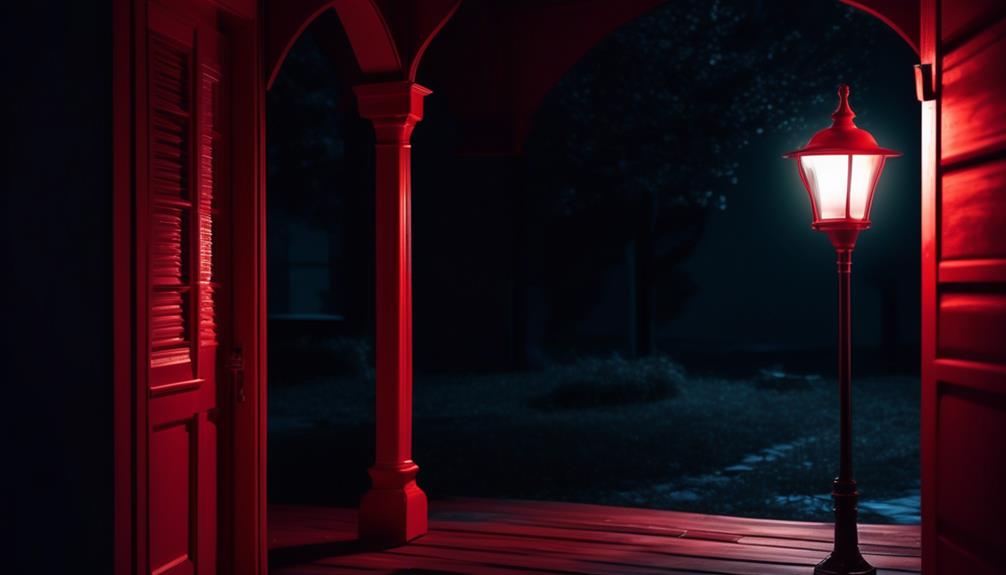
Advocating for substance abuse awareness invites us to shine a light on the impact of addiction and the importance of support and understanding for those affected. How can we create supportive communities that foster substance abuse prevention? Let's explore the role of advocacy in addressing substance abuse and promoting a culture of support and understanding.
| Supportive Communities | Substance Abuse Prevention |
|---|---|
| Encouraging open dialogue about substance abuse | Implementing educational programs |
| Providing access to resources for individuals and families | Promoting healthy coping mechanisms |
| Creating non-judgmental spaces for individuals to seek help | Advocating for policies that limit access to addictive substances |
Supportive communities play a crucial role in substance abuse prevention by offering understanding, resources, and encouragement for individuals struggling with addiction. By fostering an environment of support and empathy, we can work towards preventing substance abuse and promoting healthier lifestyles. How can we each contribute to creating a more supportive community for those affected by substance abuse?
Signaling Support for Anti-Trafficking Initiatives

Have you ever wondered about the symbolism of the color red and its impact on raising awareness for anti-trafficking initiatives?
How does the simple act of displaying a red porch light signal support for such important causes?
Let's explore the powerful message behind this symbolic gesture and its potential to spark conversations and drive action against human trafficking.
Symbolism of Red
Why does the color red hold significant symbolism in signaling support for anti-trafficking initiatives? Red symbolism carries cultural significance, representing both danger and courage. Here are three reasons why the color red is used to signal support for anti-trafficking initiatives:
- Visibility: Red is a bold and attention-grabbing color, making it an effective tool for raising awareness about the issue of human trafficking. It serves as a visible symbol of solidarity with victims and survivors.
- Passion and Action: The color red is often associated with passion and action. By displaying red, individuals demonstrate their commitment to taking action against human trafficking and advocating for change.
- Historical Context: Throughout history, red has been used to symbolize resistance and revolution. By utilizing this color, anti-trafficking initiatives draw on this historical significance to ignite a movement against modern-day slavery.
The color red, through its symbolism and cultural connotations, serves as a powerful tool in the fight against human trafficking.
Impact on Awareness
The significance of the color red in signaling support for anti-trafficking initiatives prompts an exploration of its impact on raising awareness about the issue of human trafficking.
How does the public perceive the display of red porch lights as a symbol of solidarity against human trafficking? Can this simple act of displaying a red porch light truly contribute to social change?
By understanding the public perception of the red porch light and its association with anti-trafficking efforts, we can gauge its effectiveness in raising awareness and sparking conversations about this critical issue.
How does such a visible display influence attitudes and behaviors towards human trafficking?
Exploring the impact of the red porch light on awareness not only sheds light on its potential significance but also offers insights into the power of collective action in addressing social injustices.
Red Porch Light for Fallen Firefighters

In honor of fallen firefighters, the red porch light serves as a symbol of remembrance and gratitude for their selfless service and sacrifice. The red porch light not only pays tribute to these fallen heroes but also shows unwavering support and solidarity for their families and fellow firefighters.
The red glow emanating from homes and businesses across communities signifies a collective acknowledgment of the bravery and sacrifice made by these courageous individuals.
Here are three significant reasons why the red porch light for fallen firefighters holds profound meaning:
- Visibility and Awareness: By illuminating our surroundings with a red glow, we raise awareness about the sacrifices made by firefighters and the risks they face daily. It prompts conversations and educates others about the challenges and dangers encountered in the line of duty.
- Support Network: The red porch light serves as a visual demonstration of support for the firefighting community. It symbolizes our unwavering solidarity with those who've lost their comrades and loved ones in the line of duty.
- Continued Tribute: The enduring display of red porch lights ensures that the memory of fallen firefighters remains alive in our communities. It serves as a perpetual tribute to their courage and selflessness.
The red porch light is a powerful and meaningful gesture, reminding us to honor and remember the sacrifices made by these brave individuals.
Community Safety and Awareness

Promoting community safety and awareness through proactive measures ensures a resilient and secure environment for all residents. How can we engage our community to enhance neighborhood safety?
Community engagement plays a crucial role in creating a safe and secure environment for everyone. By fostering open communication and collaboration among residents, law enforcement, and local authorities, we can effectively address safety concerns and implement preventive measures.
Neighborhood safety goes beyond physical security; it encompasses a sense of trust, support, and well-being within the community. How can we cultivate a culture of awareness and vigilance among residents?
Initiatives such as neighborhood watch programs, safety workshops, and emergency preparedness training can empower individuals to take an active role in safeguarding their surroundings.
Furthermore, leveraging technology and social media platforms can facilitate rapid dissemination of safety information and alerts within the community. How can we utilize these tools to enhance community safety?
Red Porch Light for Blood Cancer Awareness
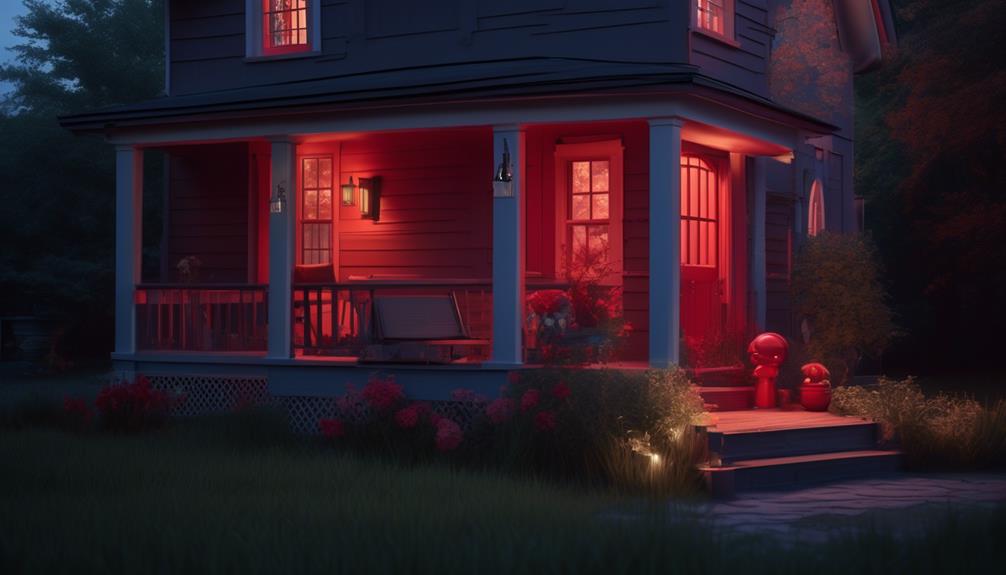
How does the use of a red porch light help raise awareness for blood cancer?
A red porch light serves as a powerful symbol of solidarity and support for those affected by blood cancer. Here's how it contributes to blood cancer awareness, fundraising, and advocacy efforts:
- Visibility and Recognition: A red porch light serves as a visible reminder to the community that blood cancer is a critical issue. By illuminating neighborhoods with red lights, we draw attention to the cause and encourage conversations about the impact of blood cancer on individuals and families.
- Fundraising Initiatives: The red porch light can be a catalyst for fundraising efforts. When community members see these lights, it prompts them to inquire about the significance and can lead to fundraising events, donations, and support for blood cancer research and patient care.
- Advocacy and Support: The widespread display of red porch lights demonstrates a collective commitment to advocacy efforts. It showcases community solidarity and provides encouragement to those battling blood cancer, letting them know they aren't alone in their fight.
Impact on Mental Health Awareness

Have you noticed the impact of a red porch light on raising mental health awareness in your community? Advocacy campaigns using red porch lights have been instrumental in fostering public awareness of mental health issues. By prominently displaying red porch lights, individuals are signaling their support for stigma reduction and mental health awareness. This simple yet powerful gesture has sparked conversations and drawn attention to the importance of mental health in our communities.
The visibility of red porch lights serves as a reminder of the need to address mental health challenges and promotes inclusivity and understanding for those affected. It creates an opportunity for individuals to express solidarity with those struggling with mental health issues and encourages open dialogue about mental well-being. The symbolic use of red porch lights has effectively contributed to breaking down barriers and reducing the stigma associated with mental health.
As we continue to explore innovative ways to advocate for mental health awareness, the red porch light movement stands as a testament to the impact of community-driven initiatives. Its influence extends beyond the physical display, sparking a collective effort to prioritize mental health and support those in need.
Frequently Asked Questions
What Are the Best Types of Red Porch Lights to Use for Different Purposes?
What are the best types of red porch lights to use for different purposes?
When it comes to outdoor fixtures, we've found that the best bulbs are energy-efficient options that can be integrated with smart technology.
Safety considerations are key, but we also consider the potential cultural implications and the psychological effects of different decorative styles.
Community engagement and fundraising strategies can be impacted, and we always consider the environmental impact.
Can the Color of a Red Porch Light Affect Its Meaning or Impact?
Does the impact of color on lighting technology extend beyond mere aesthetics?
What psychological effects and social implications might different colors have on community engagement?
And are there potential drawbacks to consider?
It's thought-provoking to delve into how the color of a porch light could influence its meaning and impact, and what this might reveal about the power of lighting in our lives.
Are There Any Specific Guidelines for Using a Red Porch Light to Show Support for a Specific Cause?
Thinking about the red light symbolism, we can use it to show support for various causes. Community engagement is key.
Specific guidelines might vary, but generally, it's a simple yet powerful way to raise awareness or express solidarity. From honoring veterans to advocating for heart health, a red porch light can convey a powerful message.
Have you considered using a red porch light to support a cause close to your heart?
How Can I Encourage My Community to Participate in Using Red Porch Lights for Advocacy?
How can we encourage our community to participate in using red porch lights for advocacy?
Encouraging participation in supporting causes and awareness initiatives can be achieved through community engagement.
What kind of outreach methods could we employ to spread the message effectively?
Are there local events or platforms where we can promote this initiative?
How can we make the use of red porch lights a visible and impactful symbol of support within our community?
Are There Any Potential Drawbacks or Negative Effects of Using a Red Porch Light for Awareness Initiatives?
What are the potential consequences of using a red porch light for awareness initiatives?
Could light pollution be a concern?
Are there any negative impacts on safety?
These are important questions to consider.
As we explore this topic, it's crucial to weigh the benefits of advocacy with the potential drawbacks.
Let's dive deeper into the impact of using red porch lights and how it may affect our communities.
Conclusion
In conclusion, the radiant red porch light serves as a symbol of solidarity, support, and awareness for various causes and communities. Its impact on mental health, veterans, substance abuse, and anti-trafficking initiatives is truly transformative.
Let's reflect on the power of this passionate porch light, and ponder how we can use its symbolic strength to spark change in our own communities.
What other causes could benefit from the glowing red porch light of hope and support?
- About the Author
- Latest Posts
Introducing Ron, the home decor aficionado at ByRetreat, whose passion for creating beautiful and inviting spaces is at the heart of his work. With his deep knowledge of home decor and his innate sense of style, Ron brings a wealth of expertise and a keen eye for detail to the ByRetreat team.
Ron’s love for home decor goes beyond aesthetics; he understands that our surroundings play a significant role in our overall well-being and productivity. With this in mind, Ron is dedicated to transforming remote workspaces into havens of comfort, functionality, and beauty.
Appliances
Carpet Pile

When choosing the ideal carpet for our homes, one aspect that is frequently ignored but is essential to the overall appearance and texture of the carpet is the pile.
As we walk through the aisles of carpet choices, the variety of pile heights and textures can be overwhelming. But fear not, for understanding the intricacies of carpet pile can lead to a more informed and satisfying decision.
So, let's unravel the mystery behind carpet pile and explore its impact on our living spaces.
Key Takeaways
- Different pile textures impact the ease of dirt and debris removal.
- Pile density directly influences comfort and durability.
- Loop pile is resilient to foot traffic and low-maintenance.
- Material composition significantly affects durability, texture, and performance.
Understanding Carpet Pile
Let's dive into the intricate world of carpet pile and unravel its secrets to understand its impact on comfort and durability.
Pile texture plays a crucial role in the maintenance of carpets. The texture of the pile affects how easily dirt and debris can be removed, as well as the overall appearance of the carpet. For instance, low pile carpets are easier to clean and maintain, making them a practical choice for high-traffic areas. On the other hand, high pile carpets can trap more dirt and require more intensive cleaning.
Pile density is another key factor that directly influences comfort. The denser the pile, the softer and more cushioned the carpet feels underfoot. This is particularly important in spaces where individuals spend significant amounts of time standing or walking, such as living rooms or bedrooms. Additionally, pile density also contributes to the carpet's durability, as denser piles are more resistant to crushing and wear over time.
Understanding these aspects of carpet pile empowers us to make informed decisions when selecting carpets, ensuring that we prioritize both comfort and practicality in our living spaces.
Types of Carpet Pile

As we explore the world of carpet pile, it's essential to understand the various types that contribute to the texture and overall characteristics of carpets. Pile construction plays a crucial role in determining a carpet's durability and maintenance requirements.
Loop pile, for instance, is known for its resilience to foot traffic and is relatively low-maintenance, making it an excellent choice for high-traffic areas. On the other hand, cut pile offers a softer, more luxurious feel, but may require more frequent vacuuming to maintain its appearance.
When considering pile texture, comfort becomes a key factor. Saxony carpets, with their dense and soft piles, offer a plush underfoot experience, making them ideal for bedrooms and living rooms where comfort is paramount. Berber carpets, with their looped pile construction, provide a firmer and more textured feel, making them suitable for areas where a more casual and rugged appearance is desired.
Understanding the different types of carpet pile empowers homeowners and designers to make informed decisions based on both practical and aesthetic considerations. By considering pile construction and texture, one can select a carpet that not only complements the space but also meets the desired comfort and maintenance requirements.
Factors Affecting Carpet Pile
Exploring the world of carpet pile types has revealed essential factors that influence carpet pile characteristics and performance. Understanding these factors is crucial for making informed decisions when choosing carpet for a particular space.
The following are key factors that significantly impact the quality and longevity of carpet pile:
- Material Composition: The type of material used in the carpet pile significantly affects its durability, texture, and overall performance. For instance, wool carpet piles are known for their natural resilience and luxurious feel, while nylon carpet piles are valued for their strength and stain resistance.
- Density: The density of the carpet pile refers to how closely the fibers are tufted together. Higher density carpet piles tend to be more durable and resilient, making them suitable for high-traffic areas. On the other hand, lower density carpet piles may offer a softer feel but are more prone to matting and wear.
- Twist Level: The twist of the carpet pile fibers impacts the carpet's appearance and performance. A higher twist level enhances the carpet's ability to resist crushing and maintain its shape over time.
Considering these factors and understanding the material composition of carpet piles can empower consumers to select the most suitable option for their specific needs.
Choosing the Right Pile for Your Space

When it comes to choosing the right carpet pile for your space, we need to consider the pile height options and the best pile for durability.
These two key points will play a crucial role in determining the overall look, feel, and longevity of your carpet.
Let's explore how these factors can make a significant difference in creating the perfect ambiance for your space.
Pile Height Options
Selecting the appropriate pile height for your carpet is crucial in creating the desired ambiance and functionality within your space. When considering pile height options, it's essential to weigh the benefits and drawbacks to make an informed decision.
- Low pile benefits:
- Easy to clean and maintain
- Ideal for high-traffic areas
- Well-suited for wheelchair access
- High pile drawbacks:
- More challenging to clean
- May not be suitable for allergy sufferers
- Prone to matting and crushing over time
Understanding these factors is essential for ensuring that the carpet not only enhances the aesthetics of the space but also aligns with practical needs. Whether it's a plush high pile for a cozy bedroom or a low pile for a busy hallway, the right pile height can greatly impact the overall functionality and appeal of the carpet.
Best Pile for Durability
What pile height best combines durability and comfort for your specific space? When it comes to choosing the best pile for high-traffic areas, low pile carpet offers numerous benefits. Its tight, short fibers provide exceptional durability, making it ideal for spaces that experience heavy foot traffic. Additionally, low pile carpet is easier to clean and less likely to trap dirt and debris, making it a practical choice for busy areas. To help you understand the differences in pile height options, we've created a comparison table below:
| Pile Height | Durability | Comfort |
|---|---|---|
| Low Pile | High | Moderate |
| Medium Pile | Moderate | High |
| High Pile | Low | High |
Consider the specific needs of your space, and weigh the benefits of each pile height to make an informed decision.
Maintaining Different Pile Types

Let's talk about the nitty-gritty of maintaining different pile types in our carpets.
We need to understand how to care for loop pile, clean cut pile, and maintain shag pile.
Each pile type requires specific attention and techniques to ensure longevity and beauty.
Loop Pile Care
Maintaining loop pile carpets requires regular vacuuming and periodic professional cleaning to preserve their appearance and extend their lifespan. Loop pile maintenance is essential for ensuring the durability of these carpets.
Here are some key tips for effectively caring for loop pile carpets:
- Use a vacuum cleaner with a brush or beater bar to effectively remove dirt and debris from the loops.
- Attend to spills and stains immediately to prevent them from setting into the loops and causing permanent damage.
- Schedule professional deep cleaning at least once a year to remove embedded dirt and revitalize the carpet fibers.
Cut Pile Cleaning
When it comes to maintaining different pile types, cut pile cleaning requires a tailored approach to effectively preserve the carpet's appearance and longevity.
For maintaining stain resistance, it's vital to promptly address any spills or stains. Blotting the affected area with a clean, white cloth and using a mild detergent solution can prevent stains from setting in.
Additionally, regular vacuuming is crucial for keeping cut pile carpets in top condition. Utilizing vacuuming techniques such as overlapping strokes and varying directions can help lift embedded dirt and prevent matting. It's also important to adjust the vacuum's height to ensure effective cleaning without causing damage to the carpet fibers.
Shag Pile Maintenance
To effectively maintain different pile types, such as shag pile, it's essential to adapt cleaning techniques to preserve the carpet's appearance and longevity. When it comes to shag pile maintenance, specific care is crucial to prevent issues like shedding and matting.
Here are some vital tips for maintaining your shag pile carpet:
- Shag pile vacuuming: Regular vacuuming is essential to prevent dirt and debris from becoming embedded in the long fibers. Use a vacuum with a brush roll designed for high-pile carpets to effectively remove dirt and maintain the carpet's fluffiness.
- Deep cleaning: Periodically, deep clean your shag pile carpet to remove deeply embedded dirt and revive its appearance. Consider professional cleaning services for thorough and effective deep cleaning.
- Shedding and matting: Keep an eye on shedding and matting, and address these issues promptly to maintain the carpet's lush and luxurious look.
Pros and Cons of Various Pile Options

As we explore the various options for carpet pile, it becomes evident that each type presents unique advantages and drawbacks. Pile construction greatly influences the durability and maintenance needs of a carpet.
Cut pile, for instance, offers a smooth and even texture, making it easier to clean and maintain. However, it may not be as durable as loop pile options, which can withstand heavy foot traffic due to their inherent strength.
On the other hand, loop pile carpets, such as Berber, may be prone to snagging and can be more challenging to clean due to their looped nature. Additionally, the texture of the carpet pile affects the overall feel and appearance of the carpet.
While a plush, high-pile carpet may exude luxury and comfort, it also tends to show footprints and vacuum marks more readily than low-pile options. Ultimately, the best choice depends on individual preferences and specific needs.
Understanding the pros and cons of various pile options is crucial in making an informed decision when selecting a carpet that aligns with both aesthetic and practical considerations.
Trends in Carpet Pile Preferences

Exploring the current shift in consumer preferences for carpet pile, we've observed a growing inclination toward low-maintenance options that offer both durability and aesthetic appeal. This shift is driven by the desire for a carpet that not only enhances the visual appeal of a space but also requires minimal effort to maintain its pristine condition.
When it comes to pile texture preferences, consumers are leaning towards softer and plushier textures, providing a luxurious feel underfoot while maintaining durability. Additionally, there's a noticeable trend towards loop pile carpets, which offer a modern and stylish appearance, adding depth and dimension to the room.
As consumers become increasingly conscious of the environmental impact of their choices, there's a growing demand for sustainable materials in carpet production. This has led to a surge in the popularity of eco-friendly options, such as carpets made from recycled materials or natural fibers like wool. These sustainable materials not only align with eco-conscious values but also offer exceptional durability, meeting the high standards of today's discerning consumers.
-Is Carpet Pile Important for a Carpet on a Concrete Floor?
When installing carpet on concrete floor, the pile is crucial for comfort and durability. A high pile can provide a soft, luxurious feel underfoot, while a low pile is easier to clean and less likely to show footsteps and vacuum marks. Both options can work well on a concrete floor, depending on your preferences.
Frequently Asked Questions
Can Carpet Pile Be Customized to Create Unique Patterns or Designs?
Yes, carpet pile can be customized to create unique patterns or designs. By manipulating the height, density, and texture of the fibers, we can craft intricate patterns and designs that are truly one-of-a-kind.
This customization allows for endless creative possibilities, making it an excellent choice for those seeking distinctive and personalized flooring solutions. The ability to tailor the carpet pile to specific design requirements ensures a truly bespoke and exceptional result.
Are There Any Environmentally-Friendly Options for Carpet Pile Materials?
When considering environmentally-friendly options for carpet pile materials, there are various sustainable choices available.
Eco-friendly options such as recycled nylon, wool, and natural fibers like jute or sisal are gaining popularity.
These materials not only reduce environmental impact but also offer durability and aesthetic appeal.
How Does Carpet Pile Impact the Acoustics of a Room?
Carpet pile significantly impacts room acoustics. The thickness of the carpet and the material play a vital role in sound absorption and noise reduction. Thicker carpet with a dense pile can effectively dampen sound, reducing echoes and creating a more acoustically balanced environment.
This is a critical consideration for spaces where noise control is important, such as offices, theaters, or recording studios.
What Are the Best Practices for Cleaning and Maintaining High Pile Carpets?
We've found that high traffic areas in homes or offices require a meticulous cleaning regimen for high pile carpets. Stain removal is a top priority, and we've discovered that regular vacuuming, using a carpet rake, and spot cleaning with a gentle detergent can maintain the carpet's appearance and longevity.
Additionally, professional cleaning every 12-18 months is crucial to remove deeply embedded dirt and allergens, ensuring a healthy and pristine environment.
Can Carpet Pile Affect the Insulation and Energy Efficiency of a Room?
Yes, carpet pile can significantly affect the energy efficiency and thermal insulation of a room. The density and height of the pile impact how well the carpet retains heat, which directly influences the room's energy consumption.
Additionally, the type of material and construction of the carpet pile can also play a role in its insulating properties. Therefore, choosing the right carpet pile is crucial for maximizing energy efficiency and maintaining thermal insulation in a room.
Conclusion
In conclusion, carpet pile is like a forest of options, with each type offering its own unique benefits and drawbacks.
From the plush comfort of cut pile to the durability of loop pile, there's a pile for every preference.
By considering factors like foot traffic and maintenance, we can choose the perfect pile for our space.
So, let's tread through the lush landscape of carpet pile and find the perfect fit for our homes.
- About the Author
- Latest Posts
Introducing Ron, the home decor aficionado at ByRetreat, whose passion for creating beautiful and inviting spaces is at the heart of his work. With his deep knowledge of home decor and his innate sense of style, Ron brings a wealth of expertise and a keen eye for detail to the ByRetreat team.
Ron’s love for home decor goes beyond aesthetics; he understands that our surroundings play a significant role in our overall well-being and productivity. With this in mind, Ron is dedicated to transforming remote workspaces into havens of comfort, functionality, and beauty.
Appliances
Doorknob Height
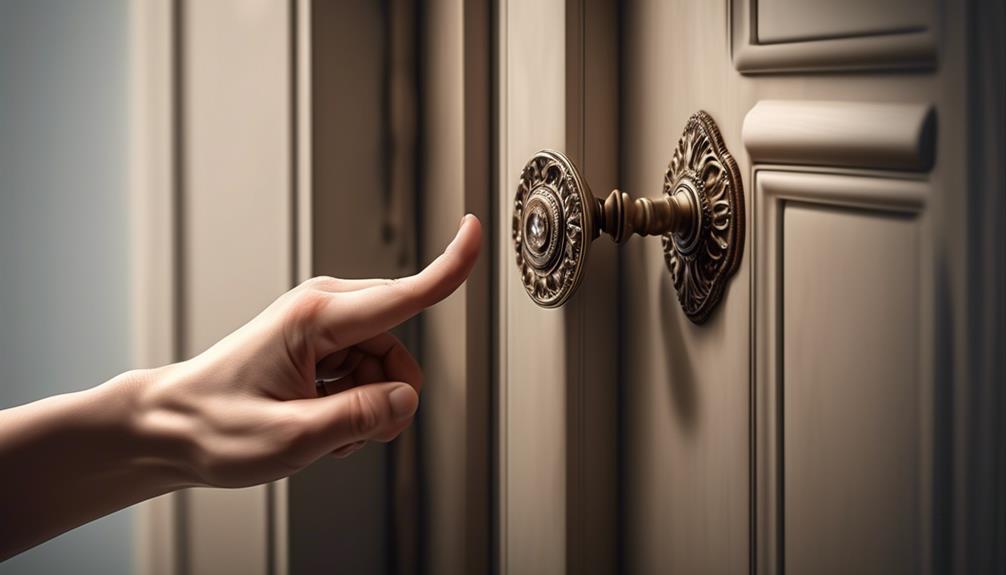
We’ve all experienced the frustration of reaching for a doorknob that is either too high or too low, leading to an awkward moment of fumbling.
But have you ever stopped to consider the actual importance of doorknob height in our daily lives? Well, let's just say there's more to it than meets the eye.
From ergonomic factors to accessibility considerations, the height of a doorknob can significantly impact our daily comfort and convenience.
But what exactly goes into determining the ideal doorknob height, and how can we ensure that it meets our needs? Stay tuned as we explore the various factors and tips for choosing the right doorknob height that could make a surprising difference in your daily routine.
Key Takeaways
- Optimal doorknob height ensures safety and convenience of use for individuals.
- Incorrect doorknob height can pose challenges for individuals with limited reach or mobility issues.
- Strategic doorknob placement optimizes safety and functionality within a space.
- Ergonomic doorknob design, such as lever-style handles and large grips, accommodates individuals with disabilities or limited hand strength.
Importance of Doorknob Height
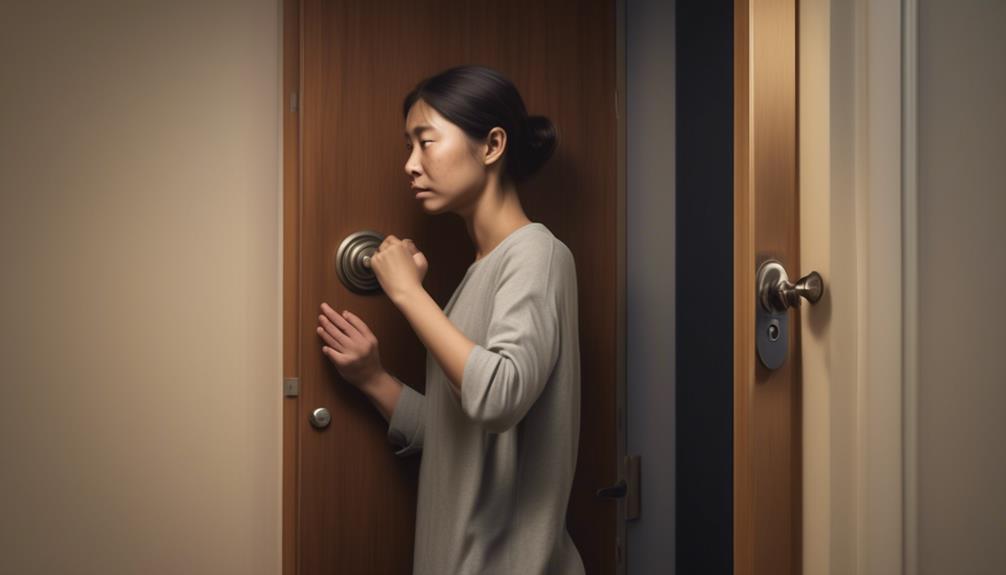
Choosing the appropriate doorknob height is essential for ensuring accessibility and ease of use for all individuals. Doorknob usability is greatly influenced by its height, impacting the safety and convenience of its use. Safety considerations are paramount when determining the optimal doorknob height, as it directly affects the ability of individuals to open and close doors without strain or risk of injury.
When discussing doorknob usability, it's crucial to consider the diverse needs of all potential users. A doorknob set too high may pose challenges for individuals with limited reach, while a doorknob set too low can create difficulties for those with mobility issues. Additionally, the height of the doorknob impacts the overall safety of the environment, as it can affect the ability of individuals to swiftly and securely open doors in emergency situations.
Factors Affecting Doorknob Placement

Careful consideration of architectural and ergonomic factors is crucial in determining the optimal placement of doorknobs within a space.
When it comes to factors affecting doorknob placement, one important consideration is child safety. It's essential to install doorknobs at a height that's out of reach of young children to prevent them from accessing certain areas, such as hazardous rooms or spaces. Additionally, adjustable doorknobs can be a valuable solution in homes with both children and adults, as they allow for flexibility in adjusting the doorknob height as children grow, ensuring continued safety without the need for frequent replacements.
Architectural factors also play a significant role in doorknob placement. The style of the door, its material, and the overall design of the space can influence the ideal placement of doorknobs. For instance, the type of door handle chosen may impact the ease of use and accessibility for individuals with varying physical abilities.
Ultimately, by carefully considering these factors, one can ensure that doorknobs are strategically placed to optimize both safety and functionality within a given space.
Ergonomic Considerations for Doorknob Height
Considering human factors in design, the placement of doorknobs should align with ergonomic principles to ensure ease of use and accessibility for all individuals. Doorknob usability is crucial in determining the effectiveness of a door handle. Ergonomic door handles should be designed to accommodate a wide range of users, including individuals with disabilities or limited hand strength.
The height of the doorknob is a critical factor in its usability. Research indicates that the most comfortable and accessible height for a doorknob is typically between 34 to 48 inches above the finished floor level. This range allows for easy reach and operation by individuals of varying heights and abilities.
Additionally, the shape and grip of the doorknob should be carefully considered to ensure a comfortable and secure grasp. Lever-style handles, for instance, are often preferred over traditional round doorknobs as they require less hand strength to operate.
Designing for Accessibility

When designing for accessibility, we prioritize ergonomic doorknob design and user-friendly accessibility features. Our focus is on incorporating universal design principles to ensure that everyone, regardless of ability, can easily navigate and interact with the built environment.
Ergonomic Doorknob Design
Designing ergonomic doorknobs for accessibility involves considering the needs of individuals with limited dexterity or mobility. To achieve this, we focus on:
- Lever Handles: Lever-style doorknobs are easier to operate for individuals with limited hand strength or mobility.
- Large Grips: Designing doorknobs with larger, ergonomic grips can accommodate a wider range of hand sizes and reduce the effort needed to turn the knob.
- Smooth Operation: Ensuring that doorknobs turn smoothly with minimal resistance can benefit individuals with limited dexterity.
- Contrasting Colors: Using contrasting colors for doorknobs and doors can aid individuals with visual impairments in locating and differentiating the doorknob.
Incorporating these design elements can significantly enhance the usability and accessibility of doorknobs for individuals with diverse needs.
User-Friendly Accessibility Features
Incorporating user-friendly accessibility features into doorknob design enhances usability and accommodates diverse needs. When designing for accessibility, it's crucial to adhere to established accessibility standards to ensure that the doorknobs are user-friendly for individuals with varying abilities.
This includes features such as lever handles for easy gripping and turning, especially for individuals with limited hand strength or dexterity. Additionally, ensuring that the doorknob height and placement comply with accessibility standards is essential for individuals using mobility aids such as wheelchairs or walkers.
Universal Design Principles
Considering universal design principles is essential for creating accessible and inclusive environments, especially when focusing on doorknob height and placement. Inclusive architecture requires careful attention to detail and a thorough understanding of the needs of all individuals. When designing for accessibility, we must consider:
- Flexibility: Ensuring that spaces and features can be used by people of various abilities and preferences.
- Simple and Intuitive Use: Designing products and spaces that are easy to understand and operate for all users.
- Equitable Use: Providing designs that are useful and marketable to people with diverse abilities.
- Perceptible Information: Incorporating designs that communicate necessary information effectively to all individuals, regardless of sensory abilities.
Tips for Choosing the Right Doorknob Height
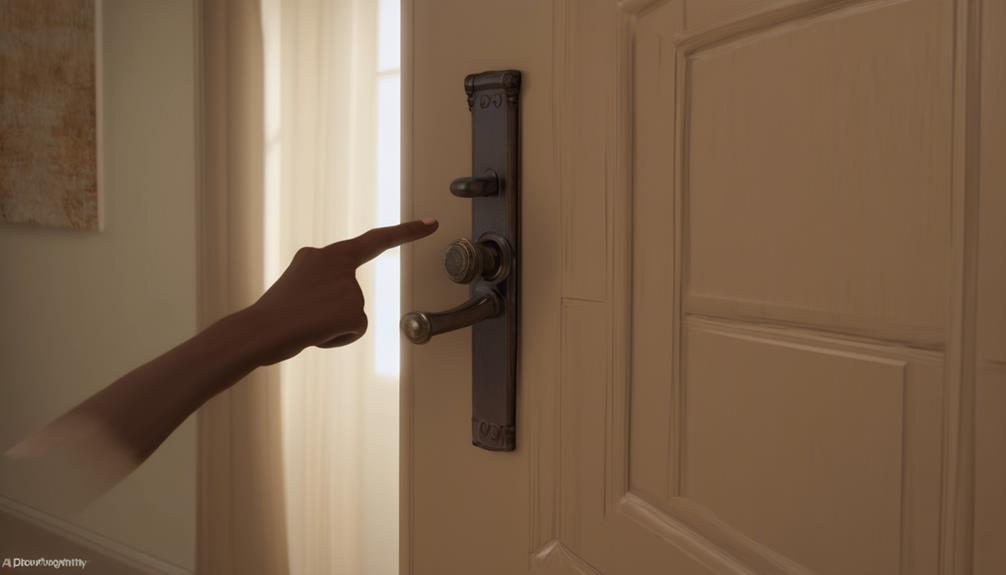
Determining the appropriate height for a doorknob is crucial for ensuring both accessibility and comfort in a space. When choosing the right doorknob height, consider childproofing options and decorative styles.
For families with young children, selecting a doorknob that can be installed at a height out of a child's reach can help enhance safety. Additionally, incorporating decorative styles can add a touch of elegance to the overall design of the space.
For senior-friendly options, prioritize ease of use and accessibility. Opt for doorknobs that are at a comfortable height for individuals with limited mobility, making it easier for them to open and close doors without strain. Customizable finishes also play a significant role in selecting the right doorknob height. Choose finishes that complement the overall aesthetic of the room, whether it's a modern, traditional, or eclectic design.
It's important to note that while these considerations are essential, individual preferences and specific needs should always be taken into account when selecting the appropriate doorknob height. By carefully evaluating childproofing options, decorative styles, senior-friendly options, and customizable finishes, you can ensure that the chosen doorknob height not only meets practical needs but also contributes to the overall ambiance of the space.
Installation and Adjustment Techniques

We can adjust the doorknob height during installation using a screwdriver to ensure it aligns with the user's preferences and needs. Here are the installation techniques and adjustment methods to achieve the perfect doorknob height:
- Measure Twice, Drill Once: Before drilling any holes, carefully measure and mark the desired doorknob height on the door. Double-check the measurements to avoid any errors.
- Choose the Right Tools: Use a quality hole saw or spade bit to create a clean and precise hole for the doorknob. A handheld drill or drill press can be used for this purpose.
- Adjusting the Latch: After installing the doorknob, ensure that the latch aligns properly with the strike plate on the door frame. Adjust the position of the latch if necessary to achieve a smooth and secure operation.
- Fine-Tuning the Height: Once the doorknob is installed, make any necessary height adjustments using the provided screws. Test the doorknob to ensure it functions smoothly and comfortably for the user.
Frequently Asked Questions
Can I Install a Doorknob at Any Height I Prefer, or Are There Regulations and Standards to Follow?
We need to consider regulations and standards when installing an adjustable doorknob. This is crucial for ensuring child safety and accessibility.
The height of the doorknob should adhere to these requirements to prevent accidents and ensure that everyone, including children and individuals with disabilities, can easily access the door.
Compliance with regulations and standards is essential for creating a safe and inclusive environment within a building.
Are There Specific Doorknob Heights Recommended for Different Types of Doors (E.G. Interior Vs. Exterior, Bedroom Vs. Bathroom)?
When it comes to doorknob customization, considering accessibility options is crucial. Various factors, such as door type and location, should guide your decision.
For instance, interior doors may have different requirements than exterior ones, and bedroom doorknobs may differ from those in bathrooms. Understanding these nuances will ensure that you make informed choices, meeting both functional and regulatory standards.
How Can I Determine the Ideal Doorknob Height for Individuals With Limited Mobility or Disabilities?
In accessible design, ergonomic solutions are crucial to accommodate individuals with limited mobility or disabilities. Determining the ideal doorknob height involves considering factors like reach range and ease of operation.
It's essential to assess the specific needs and abilities of the individual to ensure the doorknob is positioned at a height that enables comfortable and independent use. This approach promotes inclusivity and enhances the overall functionality of the space.
Are There Any Common Mistakes to Avoid When Installing or Adjusting Doorknob Heights?
When installing or adjusting doorknob heights, common mistakes include improper measurements and overlooking accessibility solutions. It's crucial to follow installation guidelines to ensure proper functionality.
Taking the time to consider the needs of individuals with limited mobility or disabilities is essential. By avoiding these mistakes, we can create a more inclusive environment.
What Are Some Alternative Options for Door Accessibility for Individuals Who May Have Difficulty Reaching or Using Traditional Doorknobs?
Accessible handles and lever options are alternative options for door accessibility. These options provide easier access for individuals who may have difficulty with traditional doorknobs.
Adjustable heights and custom solutions can also be implemented for personalized accessibility needs. These choices offer greater flexibility and accommodation for various users, ensuring that door accessibility is optimized for all individuals.
Conclusion
In conclusion, choosing the right doorknob height is essential for ensuring accessibility and ease of use for all individuals. By considering ergonomic factors and designing for accessibility, we can create a more inclusive environment.
For example, in a recent renovation project, adjusting the doorknob height allowed a wheelchair user to easily navigate through the space, highlighting the impact of proper placement.
Remember, small adjustments can make a big difference in accessibility.
- About the Author
- Latest Posts
Introducing Ron, the home decor aficionado at ByRetreat, whose passion for creating beautiful and inviting spaces is at the heart of his work. With his deep knowledge of home decor and his innate sense of style, Ron brings a wealth of expertise and a keen eye for detail to the ByRetreat team.
Ron’s love for home decor goes beyond aesthetics; he understands that our surroundings play a significant role in our overall well-being and productivity. With this in mind, Ron is dedicated to transforming remote workspaces into havens of comfort, functionality, and beauty.
-

 Vetted5 days ago
Vetted5 days ago15 Best Printers of 2024: Top Picks and Expert Reviews
-

 Vetted1 week ago
Vetted1 week ago15 Best Tile Sealers for Long-Lasting Protection and Shine
-

 Vetted2 weeks ago
Vetted2 weeks ago15 Best Smelling Floor Cleaners That Will Leave Your Home Fresh and Inviting
-

 Vetted1 week ago
Vetted1 week ago14 Best Power Scrubbers for Showers That Will Transform Your Cleaning Routine
-

 Vetted2 days ago
Vetted2 days ago15 Best LED Dimmer Switches With No Flicker: Ultimate Guide for a Flicker-Free Lighting Experience
-

 Vetted2 days ago
Vetted2 days ago15 Best Evergreen Plants for Shade Gardens: A Complete Guide
-

 Mardi Gras Decoration4 days ago
Mardi Gras Decoration4 days agoWhat Do the Symbols of Mardi Gras Mean?
-

 Appliances1 week ago
Appliances1 week ago5 Best Energy-Efficient Stainless Steel Fridges 2023






